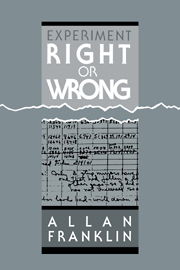Book contents
- Frontmatter
- Contents
- Preface
- Acknowledgments
- Introduction
- I EXPERIMENT AND THE DEVELOPMENT OF THE THEORY OF WEAK INTERACTIONS: FROM FERMI TO V-A
- II TOWARD A PHILOSOPHY OF EXPERIMENT
- 6 Experimental results
- 7 The roles of experiment
- 8 Do mutants have to be slain, or do they die of natural causes? The case of atomic parity-violation experiments
- Conclusion
- Appendix
- References
- Index
7 - The roles of experiment
Published online by Cambridge University Press: 15 September 2009
- Frontmatter
- Contents
- Preface
- Acknowledgments
- Introduction
- I EXPERIMENT AND THE DEVELOPMENT OF THE THEORY OF WEAK INTERACTIONS: FROM FERMI TO V-A
- II TOWARD A PHILOSOPHY OF EXPERIMENT
- 6 Experimental results
- 7 The roles of experiment
- 8 Do mutants have to be slain, or do they die of natural causes? The case of atomic parity-violation experiments
- Conclusion
- Appendix
- References
- Index
Summary
A LIFE OF ITS OWN
After the discussion of the previous six chapters, a reader might be strongly tempted to believe that experiment derives its meaning and significance solely from its relation to theory. We have mentioned the roles that experiment plays in confirming, refuting, and choosing between theories. We have also discussed the role of theory in the validation of experimental results.
As Ian Hacking (1983) has pointed out, however, experiment often has a life of its own. Although we began our history of experiment and the theory of weak interactions with Fermi's (1934) theory of β decay, the subject had been studied experimentally for more than thirty years in the absence of any accepted theory of the phenomena. Similarly, from the discovery of superconductivity by Kamerlingh Omnes in 1911 until the phenomenological theory of London and London in 1935 the experimental study of the effect proceeded in the absence of any successful theory. In fact, one might argue that the experimental discovery of the Meissner effect, the exclusion of a magnetic field from the interior of a superconductor, was a crucial step for the development of the theory. This suggests another role for experiment, that of giving hints toward a successful theory.
Sometimes experiments are done because the phenomena are seen to be interesting. In addition one might wish to acquire data that a future theory will have to explain.
- Type
- Chapter
- Information
- Experiment, Right or Wrong , pp. 142 - 161Publisher: Cambridge University PressPrint publication year: 1990



